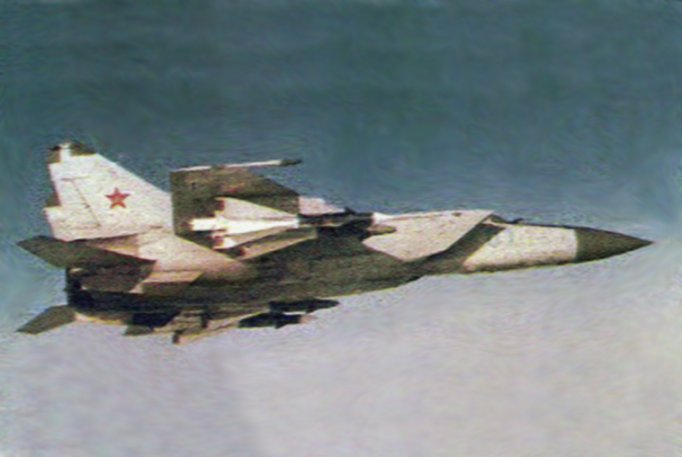Mikoyan-Gurevich MiG-25
|
|
| Contents |
Development
The development of the MiG-25 began in the 1950s, paralleling U.S. efforts to develop Mach 3 bomber and interceptor aircraft, including the (ultimately abortive) XF-103, XB-70 Valkyrie, and XF-108. As it was in the U.S., with the first Mach 2 aircraft beginning to enter service, Mach 3 seemed the next logical step. A variety of roles were considered, including cruise missile carriers, and even a small five- to seven-passenger supersonic transport, but the main impetus was a new high-altitude reconnaissance aircraft and heavy interceptor. If any of the Mach 3 bombers entered American service, they were likely to prove nearly invulnerable to Soviet air defenses.
Mikoyan-Gurevich OKB accepted the assignment effective 10 March 1961. Although the XB-70 Valkyrie was cancelled before the new aircraft, which carried the bureau designation Ye-155, reached the prototype stage, it seemed that the Ye-155 would still be a useful addition to the PVO interceptor force against targets like the SR-71 Blackbird. (Although the SR-71 was a strategic reconnaissance aircraft, a YF-12 fighter program was briefly considered, and Lockheed proposed a bomber variant that was ultimately rejected by the USAF.)
The first prototype, which was actually of the reconnaissance variant and designated Ye-155-R1 by the bureau, made its first flight on 6 March 1964. The prototype interceptor, Ye-155-P1, took to the air on 9 September 1964. Development, which represented a major step forward in Soviet aerodynamics engineering and metallurgy, took several more years to complete, but several of the prototypes, under the cover designation Ye-266, made a series of record-setting flights in 1965, 1966, and 1967.
Series production of the two initial variants, designated MiG-25P ('Foxbat-A') (interceptor) and MiG-25R ('Foxbat-B') (recce), began in 1969. The MiG-25R entered VVS service almost immediately, but the service entry of the MiG-25P with the PVO was delayed until 1972. A non-combat trainer was also developed for each version, the MiG-25PU ('Foxbat-C') and MiG-25RU, respectively. The MiG-25R evolved several subsequent derivatives, including the MiG-25RB reconnaissance-bomber, the MiG-25RBS and MiG-25RBSh with side-looking airborne radar, the MiG-25RBK and MiG-25RBF ELINT aircraft ('Foxbat-D'), and the MiG-25BM ('Foxbat-F') SEAD variant, carrying four Kh-58 (AS-11 'Kilter') anti-radiation missiles.
The MiG-25 was capable of exceptional performance, including a maximum speed of Mach 3.0 and a ceiling of 90,000 ft (27,000 m). However, its maneuverability, range, and close combat potential were extremely limited. Even its tremendous speed was problematic: although the available thrust was sufficient to reach Mach 3.2, a limit of Mach 2.8 had to be imposed to prevent total destruction of the engines. Even with that, it took a large degree of piloting skill to even throttle the engines to Mach 2.8 without overspinning the turbines.
Despite these limitations, inaccurate intelligence analysis and several false assumptions caused a panic in the West, where it was initially believed that the MiG-25 was actually an agile air-combat fighter rather than a stand-off interceptor. In response, the United States launched an ambitious new Tactical Fighter, Experimental (TFX) program, which resulted in the McDonnell-Douglas F-15 Eagle and the F-16. Thus, despite its considerable limitations, the 'Foxbat' secured its place in aviation history by spurring on these advances.
A true understanding of the attributes and failings of the MiG-25 came in 1976. On 6 September of that year a PVO pilot, Lt. Viktor Belenko, defected to the West, landing his MiG-25P 'Foxbat-A' at Hakodate airport in Japan.
As a result of Belenko's defection and the compromise of the MiG-25P's radar and missile systems, beginning in 1978 the Soviets developed an advanced version, the MiG-25PD ('Foxbat-E'), with a new RP-25 'Sapfir' look-down/shoot-down radar, infrared search and track (IRST) system, and more powerful engines. About 370 earlier MiG-25Ps were converted to this standard and redesignated MiG-25PDS.
About 1,190 MiG-25s were produced before production ended in 1984, and the type was exported to Algeria, Bulgaria, Egypt, India, Iraq, Libya, and Syria. Modest numbers remain in service.
Description
Mig25_buried_in_iraq.jpg
Although Viktor Belenko's aircraft was eventually returned to the USSR, it was first dismantled and carefully analysed by the Foreign Technology Division of the USAF, at Dayton, Ohio. After 67 days the aircraft was returned to the Russians in pieces. The analysis of Belenko's aircraft, which was brand new, showed some surprising facts:
- The MiG-25 was built primarily of nickel-steel, and not titanium as supposed. Some titanium was used in heat-critical areas. The steel construction contributed to its massive 64,000 lb (29 t) unarmed weight.
- Welding was done by hand and construction was relatively crude. Like most Soviet aircraft, in areas that would not adversely affect aerodynamic drag, rivet heads were left exposed.
- The majority of the on-board avionics was based on vacuum tube technology, not solid-state electronics. Though the Mig-25's electronics was ridiculed in the West, many experts found it ingenious and quite practical to use vacuum tubes as they were less suceptible to radiation compared to transistor technology in case of nuclear warfare. The MiG-25P's original Smerch-A (Tornado, NATO reporting name 'Foxfire') radar had enormous power of about 500 kilowatts, allowing it to burn through hostile ECM, but requiring vast amounts of pure alcohol for cooling. Pilots were forbidden to engage the radar on the ground, and legend held that it was powerful enough to kill rabbits near runways.
- The airspeed indicator was redlined at Mach 2.8, and pilots were required not to exceed Mach 2.5. The Americans had witnessed a MiG-25 flying at Mach 3.2 over Israel in 1973, a flight that had resulted in the total destruction of its engines. The Americans were unaware of the inevitability of the destruction, which helped to fuel the myths about the aircraft's capabilities.
- Combat radius was 186 miles (300 km), and maximum range on internal fuel (at subsonic speeds) was only 744 miles (1,200 km). In fact, Belenko had only just made it to Japan without running out of fuel - without sufficient fuel for a carefully planned landing, he narrowly missed a commercial airliner taking off, and overran the available runway on landing.
- Maximum acceleration (g-load) rating was just 2.2 g (22 m/s²) with full fuel tanks, with an absolute limit of 4.5 g (44.1 m/s²). This was significantly poorer performance than the previous generation F-4 Phantom. One MiG-25 withstood inadvertent 11.5 g (113 m/s²) pull during low-altitude dogfight training, but the airframe had to be written off due to deformation.
Specifications (MiG-25PD 'Foxbat-E')
- Length: 23.82 m (78 ft 2 in)
- Wingspan: 14.02 m (45 ft 11.5 in)
- Height: 6.10 m (20 ft 0.25 in)
- Wing area: 61.4 m² (661 ft²)
- Empty weight: 20,000 kg (44,080 lb)
- Normal take-off weight: 36,720 kg (80,950 lb)
- Powerplant: two Tumansky R-15BD-300 turbojets, each rated 110 kN (24,700 lbf) afterburning thrust
- Maximum speed: 3,000 km/h (1,865 mph, Mach 2.83) (engine redline-limited)
- Combat radius: 860 km (537 mi)
- Ferry range: 2,575 km (1,609 mi)
- Rate of climb: 12,480 m/min (40,950 ft/min)
- Service ceiling: 20,700 m (67,915 ft)
- Wing loading: 598 kg/m² (122.5 lb/m²)
- Thrust-to-weight ratio: 0.61:1
- Armament: four wing pylons for four R-40 (AA-6 'Acrid') air-to-air missiles; alternately, two R-23 (AA-7 'Apex') and four R-60 (AA-8 'Aphid') or R-73 (AA-11 'Archer')
External links
- Federation of American Scientists page (http://www.fas.org/nuke/guide/russia/airdef/mig-25.htm)
- GlobalSecurity.org page (http://www.globalsecurity.org/military/world/russia/mig-25.htm)
- Detailed history of the MiG-25 (http://www.vectorsite.net/avmig251.html)
- MiG 25 vs. SR-71 Blackbird discussion (http://www.wvi.com/~sr71webmaster/mig25.html)
| Related content | |
|---|---|
| Related Development | |
| Similar Aircraft | |
| Designation Series |
MiG-19 - MiG-21 - MiG-23 - MiG-25 - MiG-27 - MiG-29 - MiG-31 |
| Related Lists | List of military aircraft of the Soviet Union and the CIS - List of fighter aircraft |
|
Lists of Aircraft | Aircraft manufacturers | Aircraft engines | Aircraft engine manufacturers Airports | Airlines | Air forces | Aircraft weapons | Missiles | Timeline of aviation |


